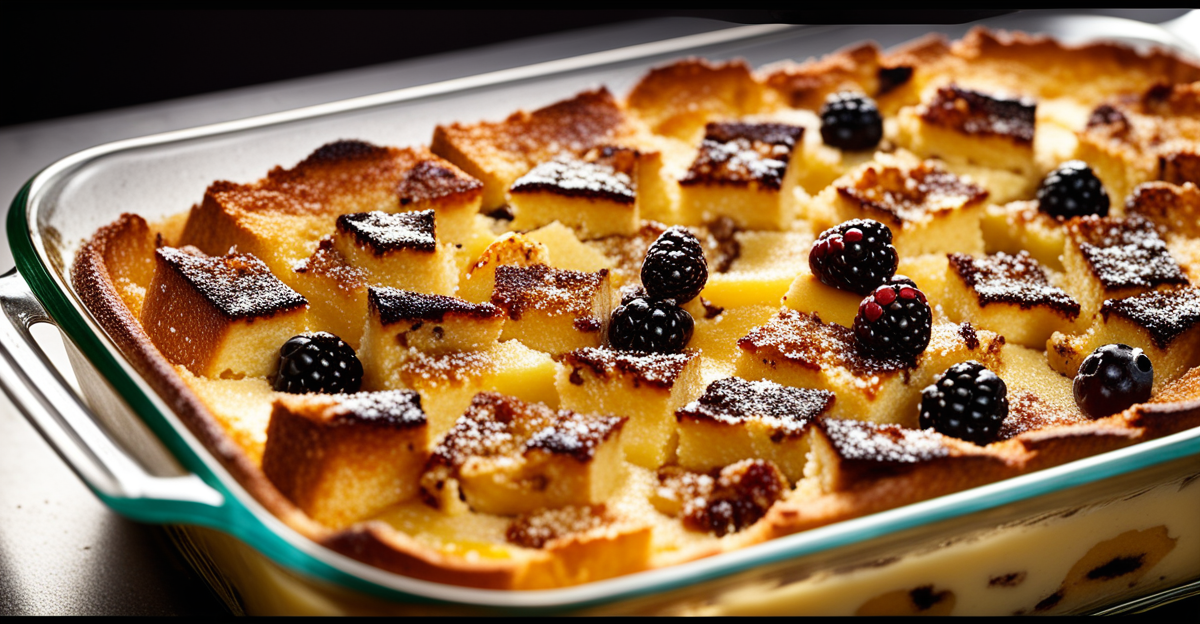Essential Ingredients for Creamy and Smooth Bread and Butter Pudding
Small, precise choices define the success of bread and butter pudding ingredients. Selecting the right dairy plays a pivotal role. Using heavy cream or a blend of cream and milk yields a richer, smoother custard compared to milk alone. The higher fat content in cream contributes to a velvety texture that elevates the pudding’s mouthfeel significantly.
When it comes to the best bread for bread pudding, thick-cut, slightly stale bread works best. Stale bread absorbs the custard without turning mushy, maintaining structure while soaking up flavors. Brioche or challah are excellent choices due to their rich crumb and buttery taste, enhancing the overall smoothness.
Have you seen this : What are the secrets to a moist and spongy Victoria sponge cake?
Eggs and sugar must be balanced carefully: eggs provide the custard’s structure and silkiness, while sugar impacts sweetness and texture. Too many eggs can yield a rubbery or eggy pudding, while too few cause it to be too soft or unstable. Typically, a moderate egg-to-milk ratio, combined with gradual sugar incorporation, ensures a creamy custard that isn’t overly dense or watery.
Ingredient tips also include warming the dairy gently before combining with eggs to prevent curdling and ensuring even custard consistency. These detailed choices make all the difference for an indulgently smooth pudding.
In parallel : What techniques can enhance the flavor of a traditional shepherd’s pie?
Step-by-Step Technique for Perfect Custard Blending
Achieving a smooth custard is crucial for creamy pudding. Start by whisking eggs gently to avoid incorporating excessive air, which creates bubbles that disrupt the texture. Gradual addition of warm dairy—whether using cream, milk, or a blend—ensures the custard thickens evenly without curdling.
Temperature control plays a vital role in custard mixing methods. Scalding the milk or cream before adding it to eggs gently heats the mixture, reducing the risk of uneven cooking or scrambling. Cold dairy introduced too quickly causes clumping, so tempering by slowly pouring warmed liquid into whisked eggs is essential to maintain smoothness.
To make a creamy pudding, avoid overbeating or vigorous whisking, which can trap air and make the custard foam rather than set properly. The goal is a glossy, thickened custard that seeps into the bread, melding flavors while maintaining silky consistency.
Ingredient tips here include keeping all components at similar temperatures before mixing and combining slowly. This careful process ensures the custard is homogenous and flawlessly coats the chosen bread—whether brioche or challah—boosting the pudding’s final lusciousness.
Baking Temperature and Timing for Optimal Texture
Finding the right oven temperature for bread pudding is key to achieving a perfectly set custard without drying out the pudding. Typically, a moderate heat around 325°F to 350°F (160°C to 175°C) works best. This range allows the custard to cook gently, setting gradually so it remains creamy rather than rubbery or overcooked.
Using a water bath (bain-marie) can greatly improve texture. Placing the baking dish inside a larger pan of hot water ensures even, gentle heat distribution. This prevents the outer edges from baking too quickly while the center stays undercooked, resulting in a uniformly smooth pudding.
The baking time for soft pudding varies, but generally falls between 35 to 50 minutes depending on the oven and dish size. To test doneness, insert a thin knife or skewer; it should come out mostly clean but with slight custard residue. If it’s too wet or jiggly, bake a few minutes longer. Avoid overbaking as it leads to a dry, curdled texture.
Bread pudding baking tips also include checking the pudding visually: the top should be golden but not burnt. Remember, residual heat will continue to cook the custard once removed from the oven, so err on the side of slightly underdone for optimal smoothness.
Essential Ingredients for Creamy and Smooth Bread and Butter Pudding
Achieving the ideal bread and butter pudding ingredients balance starts with choosing the right dairy. Between cream vs milk in custard, heavy cream or a blended mix creates a superior smoothness and richness due to its higher fat content. This fat is crucial for the custard’s velvety texture that envelops the bread perfectly.
Selecting the best bread for bread pudding is equally important. Thick slices of slightly stale bread absorb custard well without becoming mushy. Brioche and challah stand out as excellent choices because their buttery crumb enhances the dessert’s richness and structural integrity. Using fresh bread can lead to sogginess, which dilutes the creamy experience.
Balancing eggs and sugar is essential in custard making. Eggs act as a natural thickener, lending body and silkiness, while sugar not only sweetens but influences custard texture. Too many eggs can cause a rubbery consistency; too little yields a fragile custard. Aim for moderate egg quantities and gradual sugar incorporation.
Additional ingredient tips include warming dairy gently before blending with eggs to prevent curdling. Ensuring all components are at compatible temperatures facilitates an even custard mix that soaks into the bread evenly, delivering a luscious, creamy pudding every time.
Essential Ingredients for Creamy and Smooth Bread and Butter Pudding
Achieving the ideal bread and butter pudding ingredients depends largely on the smart selection of dairy. The choice between cream vs milk in custard shapes the pudding’s texture: heavy cream or a blend with milk adds richness and a silkier mouthfeel, while milk alone yields a lighter custard that may lack depth. This higher fat content in cream enhances smoothness and helps the custard coat the bread evenly.
Equally critical is selecting the best bread for bread pudding. Thick, slightly stale slices absorb custard without becoming soggy, maintaining the pudding’s structure. Brioche and challah, with their enriched crumb and buttery flavor, remain top choices for creating that creamy, smooth texture many crave. Fresh bread often leads to excess moisture, compromising pudding consistency.
Eggs and sugar must be balanced carefully in the custard base. Eggs act as a natural stabilizer and thicken the mixture to create that creamy texture, but overuse causes firmness or an eggy taste. Sugar moderates sweetness and affects texture by slightly thinning the custard. Gradual mixing of sugar with eggs and dairy ensures the ideal balance and prevents curdling—an essential ingredient tip for smooth custard blending.
Essential Ingredients for Creamy and Smooth Bread and Butter Pudding
Choosing the right bread and butter pudding ingredients is fundamental to creating creamy, smooth results. Between cream vs milk in custard, heavy cream or a cream-milk blend offers superior richness and silkiness due to higher fat content. This fat fosters a luscious mouthfeel and helps the custard coat the bread evenly. Milk alone produces a lighter custard that may lack depth in texture.
For the best bread for bread pudding, thick slices of slightly stale bread are ideal. Staling is key: slightly dried bread absorbs custard without disintegrating, preserving structure. Brioche and challah remain top choices because their dense, buttery crumb enhances overall smoothness and flavor. Fresh bread tends to soak up excess moisture, risking a soggy texture.
Eggs and sugar ratios critically influence custard creaminess. Eggs work as natural thickeners to stabilize and give body, but too many cause a rubbery or eggy pudding. Sugar balances sweetness and can modify texture slightly by thinning the mixture. Gradually incorporating sugar into eggs and dairy helps avoid curdling, yielding a stable, glossy custard.
Additional ingredient tips include warming dairy gently before mixing to prevent curdling, and ensuring ingredients are at compatible temperatures for even blending, enhancing overall pudding smoothness.



